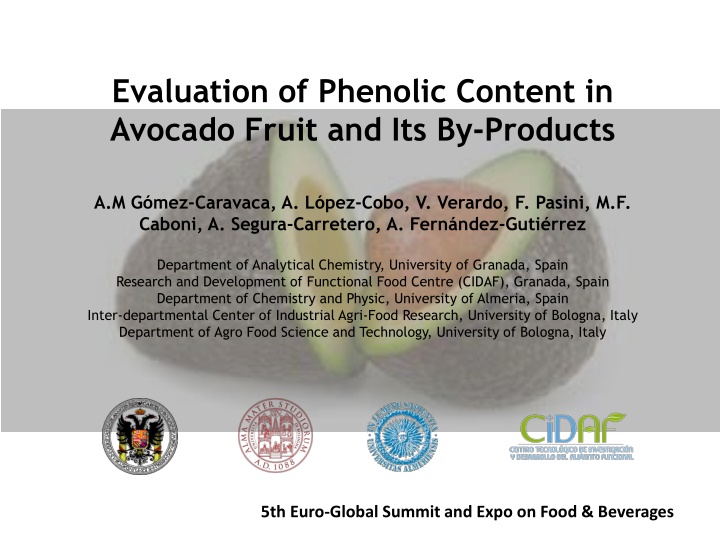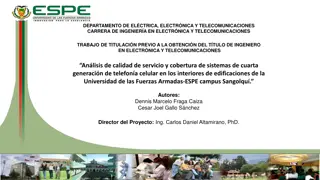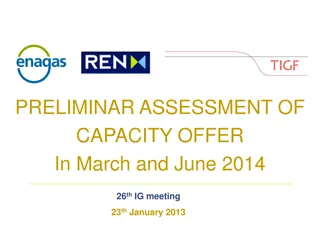
Phenolic Content Analysis in Avocado: Health Benefits and Potential Uses
Discover the extensive evaluation of phenolic content in avocado fruit and its by-products, highlighting the health benefits associated with consumption of phenolic compounds. The study aims to determine phenolic compounds in avocado pulp, seed, and peel through advanced analytical techniques, showcasing their antioxidant properties and potential as natural antioxidants for nutraceuticals and food ingredients.
Download Presentation

Please find below an Image/Link to download the presentation.
The content on the website is provided AS IS for your information and personal use only. It may not be sold, licensed, or shared on other websites without obtaining consent from the author. If you encounter any issues during the download, it is possible that the publisher has removed the file from their server.
You are allowed to download the files provided on this website for personal or commercial use, subject to the condition that they are used lawfully. All files are the property of their respective owners.
The content on the website is provided AS IS for your information and personal use only. It may not be sold, licensed, or shared on other websites without obtaining consent from the author.
E N D
Presentation Transcript
Evaluation of Phenolic Content in Avocado Fruit and Its By-Products A.M G mez-Caravaca, A. L pez-Cobo, V. Verardo, F. Pasini, M.F. Caboni, A. Segura-Carretero, A. Fern ndez-Guti rrez Department of Analytical Chemistry, University of Granada, Spain Research and Development of Functional Food Centre (CIDAF), Granada, Spain Department of Chemistry and Physic, University of Almeria, Spain Inter-departmental Center of Industrial Agri-Food Research, University of Bologna, Italy Department of Agro Food Science and Technology, University of Bologna, Italy 5th Euro-Global Summit and Expo on Food & Beverages
Avocado Composition High amount of oil (15-20 % of the pulp weight) mainly composed of unsaturated fatty acids, predominantly oleic acid. Fibre Vitamins B and E Ascorbic acid Carotenoids Sterols Phenolic compounds
Avocado Consumption Phenolic compounds health benefits The polyphenol fraction of food has been widely studied in the last years because of the healthy benefits that these compounds have consumption has been linked to the decrease of the risk of diseases associated to oxidative stress, such as cancer and cardiovascular diseases proven to provide. Its
Avocado and its by-products Large consume of avocado Pulp Seed Peel High production of avocado by-products Higher antioxidant activities than avocado pulp Potential source of natural antioxidants to be used as nutraceuticals and food ingredients
Aim of the study Determine phenolic compounds in avocado pulp and its by-products (seed and peel) by using HPLC-DAD-qTOF-MS. Determine oligomeric proanthocyanidins specifically by HPLC-FLD Antioxidant activity by ABTS, FRAP and ORAC
Experimental section Lyophilization Seed Extraction Hass Avocado Peel Analytical separation Pulp Identification and quantification
Analyses performed Phenolic compounds Solid-Liquid extraction MeOH/H2O 80/20 HPLC-DAD-QTOF-MS Oligomer proanthocyanidins Solid-Liquid extraction Acetone/H2O 80/20 HPLC-FLD Antioxidant activity ABTS, FRAP and ORAC Counter plate
Determination of phenolic and other polar compounds PULP m/z m/z Retention time (min) Molecular Formula Error (ppm)Score Compounds experimental (M-H) 211.0829 191.0571 191.02 117.0194 243.0625 315.0722 443.1934 385.1143 341.0886 443.1929 calculated (M-H) 211.0823 191.0561 191.0197 118.0194 243.0631 315.0722 443.1923 385.114 341.0878 443.1923 Fragments Perseitol Quinic acid Citric acid Succinic acid Uridine Protocatechuic acid-4-glucoside Penstemide Sinapic acid-hexoside Caffeoylglucose Penstemide 0.577 0.743 1.164 1.585 1.592 3.168 3.81 4.502 4.713 5.122 C7H16O7 C7H12O6 C6H8O7 C4H6O4 C9H12N2O6 C13H16O9 C21H32O10 C17 H22 O10 C15H18O9 C21H32O10 2.7 5.7 1.4 0.93 3.48 0.08 1.72 0.64 2.36 1.13 97.5 93.18 99.04 86.3 96.54 99.63 98.11 99.37 96.88 98.82 111 100 227 108, 153 101 223 161, 133, 179 101, 113, 161 299,119, 113, 137, 131, 149,179, 161 163,145 145,163 145, 117, 119 193,175 163, 145 193,175 Tyrosol-hexoside-pentoside 5.187 431.1562 431.1559 C19H28O11 0.85 98.51 p-Coumaric acid glucoside p-Coumaric acid hexoside pentoside p-Coumaric acid glucoside isomer 1 Feruloylglucoside p-Coumaric acid rutinoside Feruloylglucoside isomer 1 Octyl gallate Feruloylquinic acid Coumaric acid Feruloylquinic acid isomer 1 Feruloylquinic acid isomer 2 Conduritol F-1-O-(6 -O-E-p-caffeoyl)-d- glucopyranoside 5.682 5.964 6.053 6.219 6.302 6.545 6.55 7.176 7.492 7.580 7.946 325.0935 457.136 325.0934 355.1039 471.1516 355.1039 281.1393 367.1035 163.0396 367.1039 367.1039 325.0929 457.1351 325.0929 355.1035 471.1508 355.1035 281.1394 367.1035 163.0401 367.1035 367.1035 C15H18O8 C20H26O12 C15H18O8 C16H20O9 C21H28O12 C16H20O9 C15H22O5 C17H20O9 C9H8O3 C17H20O9 C17H20O9 C21H26O12 1.88 1.75 1.52 1.3 1.72 1.17 0.57 0.01 2.26 0.97 1.06 97.47 98.27 98.59 97.83 97.9 99.25 98.83 98.97 98.64 97.56 99.42 193 119 193 193 8.195 469.1354 469.1351 179 0.52 98.26
Determination of phenolic and other polar compounds PULP Compounds Quinic acid Citric acid Succinic acid Protocatechuic acid-4-glucoside Sinapic acid-hexoside Caffeoylglucose Tyrosol-hexoside-pentoside p-Coumaric acid glucoside p-Coumaric acid hexoside pentoside p-Coumaric acid glucoside isomer 1 Feruloylglucoside p-Coumaric acid rutinoside Feruloylglucoside isomer1 Octyl gallate Feruloylquinic acid Coumaric acid Feruloylquinic acid isomer 1 Feruloylquinic acid isomer 2 Total (mg/100g sample) 0,16 + 0,01 3,61 + 0,19 1,10 + 0,09 0,24 + 0,01 0,74 + 0,002 0,98 + 0,03 2,28 + 0,03 8,44 + 0,15 1,06 + 0,02 1,03 + 0,02 1,95 + 0,07 1,64 + 0,02 0,74 + 0,02 0,95 + 0,02 0,77 + 0,03 4,69 + 0,05 7,62 + 0,09 0,81 + 0,03 38,79 + 0,23
Determination of phenolic and other polar compounds PEEL m/z Retention time (min) m/z calculated (M-H) Molecular Formula Error (ppm)Score Compounds experimental (M-H) 211.0825 191.0566 443.1934 353.0889 865.2001 577.1368 289.0727 865.2008 625.1418 1153.2641 1153.2628 1153.2649 595.1308 577.1366 609.1474 Fragments Perseitol Quinic acid Penstemide Caffeoylquinic acid Procyanidin trimer Procyanidin dimer I type B Catechin/Epicatechin Procyanidin trimer II Quercetin-3,4'-diglucoside Procyanidin tetramer type B Procyanidin tetramer II type B Procyanidin tetramer III type B Quercetin-3-O-arabinosyl-glucoside Procyanidin dimer II type B Quercetin 3-O-rutinoside/Rutin 0.641 0.791 3.914 4.296 4.96 5.049 5.597 6.001 6.256 6.366 6.51 6.699 6.959 8.426 9.655 211.0823 191.0561 443.1923 353.0878 865.1985 577.1351 289.0718 865.1985 625.141 1153.2619 1153.2619 1153.2619 595.1305 577.1351 609.1461 C7H16O7 C7H12O6 C21H32O10 C16H18O9 C45H38O18 C30H26O12 C15H14O6 C45H38O18 C27H30O17 1.0 2.38 2.4 2.92 2.28 2.76 2.96 2.53 1.02 1.59 0.86 2.59 0.36 1.74 1.98 99.7 98.29 97.01 96.31 95.27 94.41 96.98 94.83 98.86 96.86 99.06 89.83 99.42 92.13 97.34 101, 113 191 577, 289 289 123 577, 289 301 289, 577,865 C60H50O24 289, 577,865 C60H50O24 289, 577,865 C60H50O24 301 289 301 C26H28O16 C30H26O12 C27H30O16
Determination of phenolic and other polar compounds PEEL Compounds Quinic acid Caffeoylquinic acid Procyanidin trimer Procyanidin dimer I type B Catechin/epicatechin Procyanidin trimer II Quercetin-3,4'-diglucoside Procyanidin tetramer type B Procyanidin tetramer II type B Procyanidin tetramer III type B Quercetin-3-O-arabinosyl- (mg/100g sample) 0,50 + 0,01 189,89 + 1,07 93,90 + 3,01 612,71 + 3,62 516,81 + 3,04 467,51 + 2,73 270,05 + 2,19 166,23 + 2,43 321,60 + 3,27 204,86 + 1,45 19,76 + 0,22 51,44 + 0,36 35,31 + 0,61 2950,59 + 2,13 glucoside Procyanidin dimer II type B Quercetin 3-O-rutinoside/Rutin Total
Determination of phenolic and other polar compounds SEED m/z m/z Retention time (min) Molecular FormulaError (ppm) Score Compounds experimental (M-H) 211.0827 191.0567 191.0197 315.1094 353.088 calculated (M-H) 211.0823 191.0561 191.0197 315.1085 353.0878 Fragments Perseitol Quinic acid Citric acid Hydroxytyrosol 1-glucoside Caffeoylquinic acid Salidroside or Tyrosol -( -D- glucopyranoside) Procyanidin dimer Penstemide 3-O-p-Coumaroylquinic acid Catechin/Epicatechin Caffeoylquinic acid Procyanidin tetramer type A Procyanidin dimer type B Procyanidin trimer type A I Catechin/Epicatechin Procyanidin trimer type A II Vanillic acid glucoside (1'S, 6'R)-8'-Hydroxyabscisic acid beta-D-glucoside 0.872 0.917 1.183 3.126 3.585 101 108 C7H16O7 C7H12O6 C6H8O7 C14H20O8 C16H18O9 C14H20O7 C30H26O12 C21H32O10 C16H18O8 C15H14O6 C16H18O9 C60H48O24 C30H26O12 C45H36O18 C15H14O6 C45H36O18 C14H18O9 C21H30O10 1.88 4.05 0.04 2.48 0.55 99.01 93.95 99.88 96.57 99 111, 101, 113 135, 153 191, 135 4.012 299.1138 299.1136 119 0.43 99.42 4.2 4.344 4.538 4.931 5.075 5.357 5.512 5.922 6.093 6.315 6.366 577.1358 443.1924 337.093 289.0726 353.0887 1151.2477 577.1355 863.1852 289.0726 863.1843 329.0878 577.1351 443.1923 337.0929 289.0718 353.0878 1151.2463 577.1351 863.1829 289.0718 863.1829 330.0951 289 101 163 123 1.03 0.18 0.27 2.64 2.54 1.16 0.47 2.69 2.77 2.08 0.14 97.94 99.74 99.8 97.27 97.08 98.17 99.09 94.25 95.5 95.34 99.06 135, 191 577,289 289 289 123 289 123, 167 8.546 441.177 441.1766 330,139 0.67 99.24
Determination of phenolic and other polar compounds SEED Compounds Quinic acid Citric acid Hydroxytyrosol 1-glucoside Caffeoylquinic acid Salidroside or Tyrosol -( -D-glucopyranoside) (mg/100g sample) 0,10 + 0,001 4,63 + 0,14 38,95 + 0,61 112,29 + 0,41 223,66 + 1,33 28,28 + 0,15 7,01 + 0,05 84,24 + 2,10 6,69 + 0,05 97,60 + 1,10 51,58 + 0,98 150,64 + 1,31 130,31 + 1,25 170,67 + 1,90 6,74 + 0,27 1113,39 + 0,76 Procyanidin dimer 3-O-p-coumaroylquinic acid Catechin/Epicatechin Caffeoylquinic acid procyanidin tetramer type A procyanidin dimer type B procyanidin trimer type A I Catechin/Epicatechin Procyanidin trimer type A II Vanillic acid glucoside Total
Antioxidant Activity ABTS FRAP ORAC (mmol eq trolox/100g sample) 46.97 0.18 168.32 14.74 1.87 0.02 (mmol eq FeSO4/100g sample) 2886.13 26.59 3800.87 37.38 50.53 0.51 ( mol eq trolox/100g sample) 44.19 0.64 100.92 4.12 6.36 0.12 Seed Peel Pulp
Determination of Proanthocyanidins Pulp 0.16 0.14 0.12 mg/g sample 0.10 0.08 0.06 0.04 0.02 0.00 cat+epic dp2 dp3 B dp4 B dp5 B Total
Determination of Proanthocyanidins 7.00 6.00 20.00 18.00 5.00 16.00 mg/g sample 14.00 4.00 12.00 Peel Seed mg/g sample 3.00 10.00 8.00 2.00 6.00 4.00 1.00 2.00 0.00 0.00 polymer Total
Conclusions 1. Avocado pulp is a good source of phenolic acids 2. Avocado fruit by-products, as peel and seed, contain high amounts of flavan-3-ols 3. Procyanidins type A are predominant in avocado seed, whereas procyanidins type B are prevalent in avocado peel 4. Avocado peel and seed could be used as raw material for the production of nutraceuticals and/or food ingredients
Evaluation of Phenolic Content in Avocado Fruit and Its By-Products A.M G mez-Caravaca, A. L pez-Cobo, V. Verardo, F. Pasini, M.F. Caboni, A. Segura-Carretero, A. Fern ndez-Guti rrez Department of Analytical Chemistry, University of Granada, Spain Research and Development of Functional Food Centre (CIDAF), Granada, Spain Department of Chemistry and Physic, University of Almeria, Spain Inter-departmental Center of Industrial Agri-Food Research, University of Bologna, Italy Department of Agro Food Science and Technology, University of Bologna, Italy 5th Euro-Global Summit and Expo on Food & Beverages






















